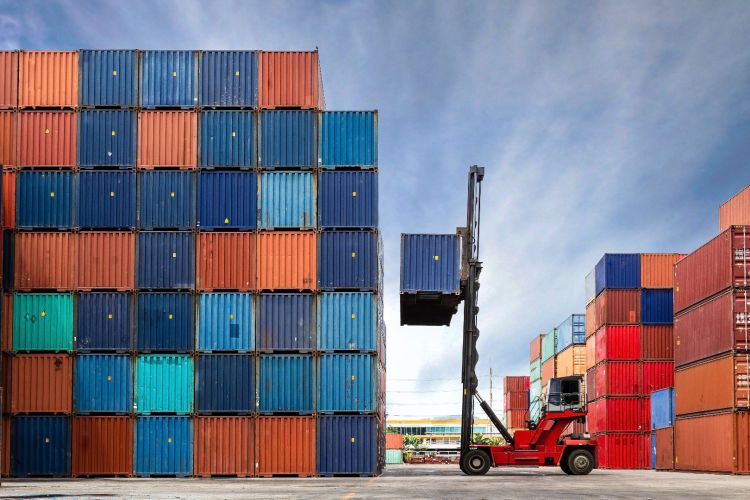- Rent, Lease, or Purchase
- |
May 11, 2018
How to Lift a Shipping Container

There is increasing pressure on shipping yards and container storage facilities to lift shipping containers quickly and efficiently. Operators work around the clock to keep up with changes in demand, commercial storage requests, and other logistics. They use robust and secure mechanisms to move shipping containers properly. Unfortunately, packed schedules can increase the chances of accidents.
On February 14, 2021, a heavy lift crane toppled over at Global Container terminals situated at Port Jersey Blvd., trapping the operator inside. Firefighters and the Port Authority police department responded immediately and used an aerial bucket to lift the operator to safety.
Such incidents highlight the need for safety norms and safe container lifting equipment for facilities that lift and transport shipping containers.
Questions About Using Spreaders and Slings to Lift Shipping Containers
Why is Lifting a Container by its Top Corners With a 4-Legged Sling Not Permitted?
A typical 4-legged sling, attached to the top corners of the container, induces a large lengthwise compression force on the top plane. Lifting the unit this way can cause slow but lasting damage to its overall structural integrity. If the operator keeps using this method, the container may suddenly break open from underneath, spilling its contents on the surface below.
Why Do You Need a Spreader Between the 4-Legged Sling and the Container?
It is best to spread the compression force using an MK-20 or MK-40 spreader. The load will no longer be applied on the roof of the unit but on the spreader itself, which can bear the weight.
This helps lift containers vertically as per international standard ISO 1496 for top lifting. This semi-automatic spreader lifting helps in quicker handling and requires a lesser number of operators.
What To Do if Spreaders Are Not Available?
If a spreader is not available, you can use the MK-5L or MK-5R. These lifting parts fit the side holes located on the bottom corners of the unit. This shifts the horizontal compression load to the floor plane. The part of the container can more easily handle heavy loads than the roof plane.
Types of Container Lifting Mechanisms
Years ago, you could only find specialized machines used to lift containers in shipping yards. But the increasing utility of shipping containers in commercial storage has created a demand for efficient and budget-friendly container lifting solutions outside that environment.
Container Lifting Jacks
This cost-effective solution can help lift a shipping container up to 70,000 lbs. You can easily use lifting jacks in locations with low container volume. You get better pricing and portability with lower speed and automation.
Pros:
- Capable of lifting various types of heavy containers
- Cost-effective ($30,000 - $75,000)
- Works well in tight spaces
- Portable
Cons:
- Does not stack the units
- Can't move containers around the site
Gantry Crane
These are large cranes that sit at docks to help lift a shipping container on and off cargo ships. These cranes can move up and down a dock but are generally stationary. The cost of these cranes runs into millions, which is why it is better to use them in areas with high container throughput.
There are smaller options available such as rail-mounted or rubber tire gantry cranes that can lift, move or stack containers in medium volume locations.
Pros:
- Fast and efficient in ports to handle high volumes of containers
Cons:
- High capital and maintenance cost (upward of $10 million)
- Fixed at one location
Straddle Carrier
Straddle carriers are similar to gantry cranes but come in different shapes and sizes. They lift containers from the top and move them around with ease. Due to their size, you can operate them only on a reinforced concrete surface.
Pros:
- Quite fast and mobile
- Can stack containers
Cons:
- Expensive (each straddle carrier costs around $2,50,000 USD)
- For use only at one site
- Needs a reinforced concrete base for operations
Reach Stacker
Reach stackers are a very fast and efficient way to lift and move heavy containers. You can move single units on-site, transfer them between the ground, the stack, rail wagons, and chassis. You can generally use reach stackers to stack up to two or three containers high and deep.
Pros:
- Fast turnaround
- Automated
- Can stack containers
Cons:
- Expensive (a new reach stacker costs around $500,000)
- Mobile, but on single site
Top Loader
This specially designed forklift can vertically lift and pile containers in a single stack.
Pros:
- Fast turnaround time
Cons:
- Expensive (a new top loader costs around $400,000)
- Limited to only one site
Forklift
Forklifts are one of the most versatile lifting machines in warehousing and manufacturing. These compact and mobile machines lift small boxes easily. Heavy-duty forklifts can also lift shipping containers that are lightweight or empty.
Proper weight distribution is necessary since these machines typically lift containers using a very small base at the center.
Pros:
- Multi-purpose
- Cost-effective
Cons:
- Can't handle all types of containers and heavyweights
- Mobile, but you can use larger forklifts on a single-site only
Side Loader
Side loaders are also called self-loading trailers, swing lifts, or side lifters. These are high-capacity chassis that can lift, transport, and transfer heavy containers from the ground or another chassis. They are especially helpful if you need to lift containers in multiple locations.
The lifting apparatus weighs up to 11,000 lbs. which increases the tare weight compared to regular chassis.
Pros:
- Quick transfer of containers in just 5-10 minutes
- Takes just one operator
Cons:
- Expensive (a side loader costs around $200,000 )
- Additional cost of prime mover
- Not commonly available
Truck Crane
Truck cranes are mounted on the back of a truck. The truck crane can move and place the shipping container anywhere within the arc of the crane's arm. However, to maintain the truck's stability, the arm of a truck crane can lift only lightweight or empty containers of up to 20-feet.
Pros:
- Useful in confined spaces
- Highly mobile across sites
- Can lift and transport other boxes apart from containers
Cons:
- Expensive (a new truck crane costs nearly $250,000)
- Limited crane capacity; can't lift heavy containers
- Can't handle all container types
Tilt Bed Truck Carrier
A tilt-bed or tilt-deck truck lowers the deck to the ground and pushes the shipping container off the vehicle on the ground. This method can offload both empty containers and containers loaded with non-expensive goods. A tilt-bed truck costs less than a side loader but has limited lifting capacity.
Pros:
- Portable
- Less expensive than other lifting options ($70,000 - $90,000)
Cons:
- Can't lift or move heavy containers
- Can't handle all container types
- Slow turnaround
- Not for goods that are fragile or need level handling
Cranes vs. Forklifts
Two of the most common methods used to lift containers are cranes and forklifts.
Every shipping container manufacturer builds the container with at least eight corner castings for twist locks that act as connection points for cranes to lift the unit.
Similarly, every container has forklift pockets at the bottom for industrial forklifts to lift and move the shipping container. This also helps load the container on trucks for further transport.
When Should You Use Forklifts for Containers?
Companies often find it easier to own and manage forklifts than cranes. If you frequently need to move shipping containers around the yard, you may find a forklift more useful. That said, you shouldn't use standard forklifts used in warehouses to lift the units.
Use only special heavy-duty forklifts to lift units with a few people around to guide the driver. To lift a 40-foot container, you need a forklift that can lift at least 15,000 lbs.
When Should You Use Cranes for Containers?
Shipping containers are becoming increasingly popular alternatives to traditional building offices and residences. Cranes are helpful if you want to stack multiple units on top of each other. Cranes can easily pick and drop containers in small areas, urban plots, or remote and rural job sites.
Cranes are, however, more expensive than forklifts. This machinery requires a crane operator, a boom guide, and at least a couple of people on the ground.
Conclusion
Lifting and moving a shipping container is a job best left to the experts in possession of the necessary equipment. A professional will typically take into account the weight of the container, the dimensions, modifications, surrounding area space, and additional factors before deciding on which lifting equipment to use.
Mobile Modular Portable Storage is one of the top names in shipping container rentals. Over the last ten years, we have increased our pickups and deliveries by over 14,200%. Our in-house fleet of trucks, industry-standard equipment, and highly skilled delivery specialists can help you with any project.
Call us at 866-459-7600. Our representatives will stay in touch from inquiry to installation to ensure safe container lifting, delivery, and unloading.
Frequently Asked Questions
How do you move a 40-foot container?
Lifting and moving a shipping container needs specialized equipment, be it a forklift or a crane. The type of equipment will depend on where your unit is located, its weight, surrounding space, and other factors.
Do you need planning permission to put a container on your land?
Usually, yes. Get in touch with your local municipal office and ask for the regulations and permissions around placing a shipping container on your property.
How do you move a shipping container by yourself?
If the container is already at your site and you want to adjust the position, you could use a jack to raise the unit, put round pipes under it, and push or pull the structure. Other methods include pulling it with an ATV (if you have one). However, we recommend that you work with delivery specialists who can help you do it right the first time.
Related Blogs



Subscribe to Our Blog
Enter your email address to subscribe to the blog and receive the notification of new posts by email.
Thank You for Subscribing to Our Blog!
Stay tuned for upcoming emails with valuable content that we hope will enhance your experience with our brand.
Both Pardot and mg360 form submissions failed.
